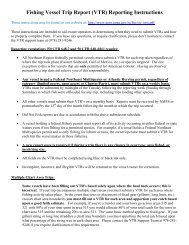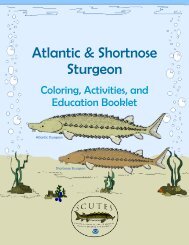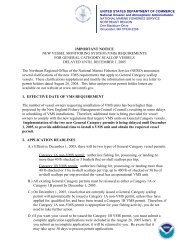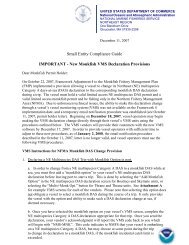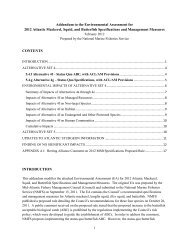modifications to the harbor porpoise take reduction plan - Northeast ...
modifications to the harbor porpoise take reduction plan - Northeast ...
modifications to the harbor porpoise take reduction plan - Northeast ...
Create successful ePaper yourself
Turn your PDF publications into a flip-book with our unique Google optimized e-Paper software.
equirements of <strong>the</strong> seasonal pinger and closure requirements of <strong>the</strong> relevant management areas<br />
(Mid-Coast, Massachusetts Bay, and Stellwagen Bank Management Areas). If <strong>the</strong> <strong>harbor</strong><br />
<strong>porpoise</strong> bycatch rate, averaged over <strong>the</strong> three areas and <strong>the</strong> most current two management years,<br />
exceed 0.031 <strong>harbor</strong> <strong>porpoise</strong> <strong>take</strong>s per observed metric <strong>to</strong>ns of landings (<strong>take</strong>s/m<strong>to</strong>ns), <strong>the</strong><br />
Coastal Gulf of Maine Consequence Area would be closed in Oc<strong>to</strong>ber and November of each<br />
year. The Oc<strong>to</strong>ber 1 through November 30 closure would remain in place until ZMRG is<br />
achieved or until <strong>the</strong> HPTRT and NMFS develop and establish new management measures.<br />
Outside of <strong>the</strong> closure period or area, pinger requirements for <strong>the</strong> three individual areas and <strong>the</strong><br />
March closure in <strong>the</strong> Massachusetts Bay Management Area would be maintained.<br />
As discussed in Section 1, compliance with <strong>the</strong> pinger measures eroded quickly after <strong>the</strong> HPTRP<br />
regulations were first implemented. Outreach, along with <strong>the</strong> “incentive” of an increased<br />
enforcement presence in <strong>the</strong> management areas, rapidly improved compliance. However,<br />
compliance has never been observed above 80% in New England waters. Participants on <strong>the</strong><br />
HPTRT agreed that <strong>the</strong> development of a <strong>plan</strong> with serious consequences for non-compliance<br />
was required <strong>to</strong> ensure that pingers would be used and maintained by New England gillnet<br />
fishermen. Ra<strong>the</strong>r than punitively implementing immediate closures due <strong>to</strong> past poor<br />
compliance with <strong>the</strong> pinger requirements, <strong>the</strong> proposed measures provide gillnet fishermen with<br />
an opportunity <strong>to</strong> achieve compliance with <strong>the</strong> pinger requirements, with closures required only<br />
as a consequence of future poor compliance. Therefore, at <strong>the</strong> December 2007 meeting, <strong>the</strong><br />
HPTRT broadly supported <strong>the</strong> establishment of “consequence” closure areas. Note that <strong>the</strong>se<br />
ideas were discussed in detail only for <strong>the</strong> Sou<strong>the</strong>rn New England Area (see ex<strong>plan</strong>ation below).<br />
Although full consensus was reached on <strong>the</strong> concept of consequence areas during <strong>the</strong> December<br />
2007 meeting, <strong>the</strong>re were many unresolved issues relative <strong>to</strong> new management measures<br />
considered for <strong>the</strong> GOM. The proposal developed by <strong>the</strong> states of Maine, New Hampshire and<br />
Massachusetts for <strong>the</strong> HPTRT’s January 2008 teleconference proposed measures for <strong>the</strong> GOM<br />
consistent with those previously accepted by <strong>the</strong> HPTRT for Sou<strong>the</strong>rn New England during <strong>the</strong><br />
December 2007 meeting. Full consensus was reached on <strong>the</strong> establishment of one consequence<br />
area that related <strong>to</strong> observed bycatch rates in three management areas: <strong>the</strong> Massachusetts Bay,<br />
Stellwagen Bank, and Mid-Coast Management Areas. This Coastal Gulf of Maine Consequence<br />
Closure Area was accepted without contention.<br />
The HPTRT discussed two possible metrics for a closure trigger: compliance estimates and<br />
<strong>harbor</strong> <strong>porpoise</strong> bycatch rate estimates. There was broad support for use of target <strong>harbor</strong><br />
<strong>porpoise</strong> bycatch rates based on <strong>the</strong> rate previously observed for hauls with <strong>the</strong> proper number of<br />
pingers deployed. Additionally, <strong>the</strong>re was broad support for using two years of data and<br />
developing two regionally distinct target bycatch rates, one for <strong>the</strong> GOM management areas and<br />
ano<strong>the</strong>r for sou<strong>the</strong>rn New England. Different bycatch rates can reflect <strong>the</strong> distribution and<br />
abundance of <strong>harbor</strong> <strong>porpoise</strong>s ra<strong>the</strong>r than ineffectiveness of pingers or non-compliance in a<br />
particular area.<br />
According <strong>to</strong> Palka and Orphanides (2008a), <strong>the</strong> bycatch rate observed on gillnet hauls during<br />
January 1, 1999, <strong>to</strong> May 31, 2007, in <strong>the</strong> three GOM Management Areas (Mid-Coast, Stellwagen<br />
Bank, and Massachusetts Bay) using <strong>the</strong> correct number of pingers is 0.031 <strong>harbor</strong> <strong>porpoise</strong><br />
34



